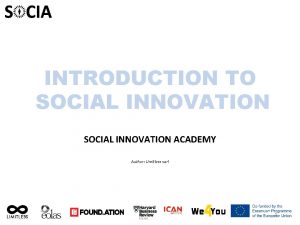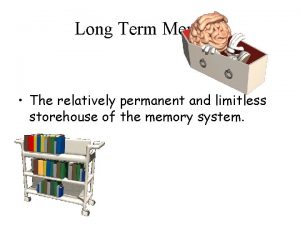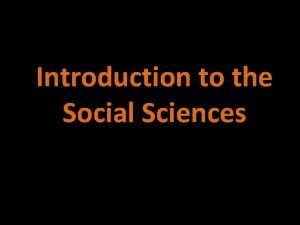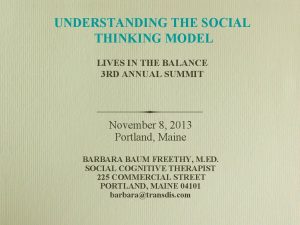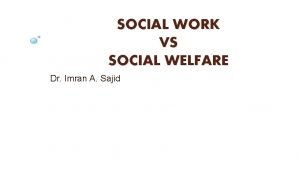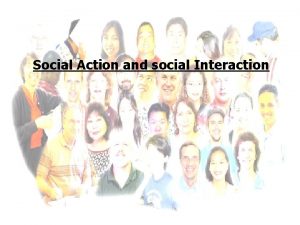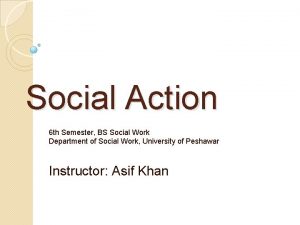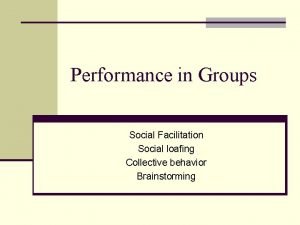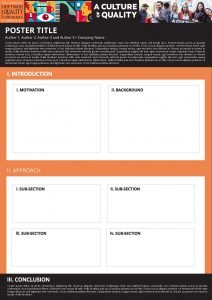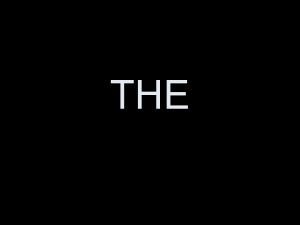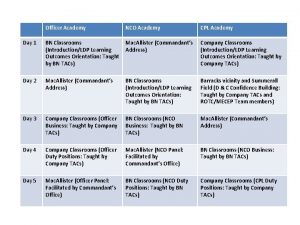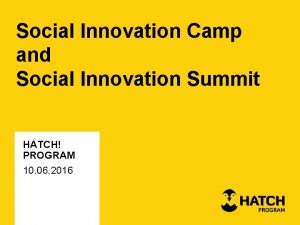INTRODUCTION TO SOCIAL INNOVATION ACADEMY Author Limitless sarl































- Slides: 31

INTRODUCTION TO SOCIAL INNOVATION ACADEMY Author: Limitless sarl 1

WHAT IS SOCIAL INNOVATION? IN SEARCH OF AN APPROPRIATE DEFINITION PRAGMATIC APPROACH SYSTEMIC APPROACH MANAGERIAL STANCE Social innovation as ‘innovative activities and services that are motivated by the goal of meeting a social need and that are predominantly developed and diffused through organisations whose primary purposes are social. ’ 1 A ’complex process through which new products, processes or programmes are introduced, leading to a deep change in daily routines, resources’ streams, power relations or values within the system affected by the innovation. ’ 2 Social innovation as a ’new solution to a social problem which is more effective, efficient, sustainable or fairer compared to existing solutions, and which generates value primarily for society instead of single individuals or organisations. ’ 3 ECONOMIC APPROACH CRITICAL APPROACH SHORT APPROACH Social innovation defined as ‘conceptual, process or product change, organisational change and changes in financing, and new relationships with stakeholders and territories. ’ 4 A process of ‘empowerment and political mobilisation’ targeting a bottom-up transformation of the functioning of a social system, in terms of stakeholders and in terms of distribution of material and immaterial resources. 5 We like keeping things simple, so for us, social innovation is ’innovation that is social both in its ends and its means. ’ 6 2 1) 2) 3) Mulgan et al. (2007). Social Innovation, What It Is, Why It Matters, and How it Can Be Accelerated Westley (2010). Making a Difference- Strategies for Scaling Social Innovation for Greater Impact Phills et al. (2008). Rediscovering Social Innovation 4) OECD (2009). Transforming innovation to address social challenge 5) Moulaert et al. (2009). Social Innovation and Territorial Development 6) Murray et al. (2010). The Open Book of Social Innovation

WHAT CAN YOU GAIN FROM SOCIAL INNOVATION? Besides that: Partners Financially • Reduced costs • Increased revenue • Higher sales • Increased margins • Greater profit • Sustainable relationship with all players involved • Increased satisfaction of shareholders THE BENEFITS The main benefit: the added value for society. Reputation • Improved brand awareness • Better image • Larger audience • Positive brand experience • More recommendations • Larger differential advantage Chances for innovation • New products / services • New forms, models or systems of collaboration • New business models • Better processes Customers • Better relationship with customers • More involvement of employees • Increased customer satisfaction • Better service experience 3 1) NAS, D. (2015) An introduction to Social Innovation, https: //www. slideshare. net/deborahnas/the-creativetribe-socialinnovationenglish 20140709 highres

WHAT SOCIAL INNOVATION IS NOT THE CONFUSION BEHIND SOCIAL INNOVATION Social innovation is not a new concept and should not be considered similar to other definitions, such as social entrepreneurship, creativity or invention, improvement or change. 'As with innovation in technology or business, social innovation is distinct from ‘improvement’ or ‘change’ and from ‘creativity’ and ‘invention’. These last two are both crucial to innovation but overlook the important stages of implementation and diffusion which make new ideas useful. '1 SOCIAL ENTREPRENEURSHIP 'Whilst social innovation certainly occurs through social enterprise and social entrepreneurship it also happens in many other contexts. Conversely, although social entrepreneurship often involves innovation, only a small minority of social entrepreneurs create new models that can then be scaled up, and that process of scaling up often involves governments and larger businesses. '2 IMPROVEMENT / CHANGE Innovation requires change. Change is doing something different, while innovation is about getting better concurrently. Social innovation requires the implementation of a strategy, while change or improvement might not. CREATIVITY / INVENTION Creativity is the ability to originate new ideas, while innovation is the transition of the mental state to the actual implementation of those ideas. Invention is a process referring to parthenogenesis Inventions are mostly seen out of business or society, in universities and research institutes. 4 1) 2) European Union/The Young Foundation (2010). Study on Social Innovation, p. 15 Mulgan et al. (2007). Social Innovation, What It Is, Why It Matters, and How it Can Be Accelerated, p. 45

SOCIAL INNOVATION IS NOT ‘NORMAL’ INNOVATION THE DIFFERENCES BETWEEN THE TWO ‘SOCIAL INNOVATION PROJECTS ARE: ‘NORMAL’ INNOVATION PROJECTS ARE: • ‘Multidisciplinary and aimed at integrated solutions • Focused on stand-alone solutions • Focused on empowerment and working together • Determined from the top-down • Driven by demand • Driven by supply • Custom-made • Mass-produced • Approached in an open manner to allow the sharing • More closed and confidential in approach’ 1 of knowledge and intellectual property 5 1) NAS, D. (2015) An introduction to Social Innovation, https: //www. slideshare. net/deborahnas/the-creativetribe-socialinnovationenglish 20140709 highres

SOCIAL INNOVATION EXAMPLES (1/2) SOCIAL INNOVATION IN PRACTICE “The emerging field of social innovation is rich and varied – from new models of learning and eldercare to new ways to reduce waste, empower communities and transition to a low carbon economy – and there are many organisations and individuals engaged in the development and use of social innovation across Europe. ” 1 Below, see some examples of social innovations that have made the world a better place thanks to their long-lasting social impact. 2 Open University kiva Repair Café And other models of distance learning that transformed the way people engage and interact with education. The world’s first peerto-peer micro-lending site allowing people to ‘lend money via the Internet to lowincome entrepreneurs and students in over 80 countries. ’ 4 Its mission is to alleviate poverty. ‘Repair Cafés are free meeting places and they’re all about repairing things (together). There are over 1. 500 Repair Cafés worldwide. 3 Grameen The Freebird Club Grameen Bank is a microfinance organisation that alongside BRAC is empowering poor people to end poverty and hunger. A peer-to-peer social travel and home stay platform designed specifically for people over 50. It addresses loneliness and financial stability. Fair Trade A social movement pioneered in the UK & USA with a mission to aid producers in developing countries achieve better trading conditions. 1) 2) 3) 4) European Union/The Young Foundation (2010). Study on Social Innovation Mulgan et al. (2007). Social Innovation, What It Is, Why It Matters, and How it Can Be Accelerated https: //repaircafe. org/en/about/ https: //en. wikipedia. org/wiki/Kiva_(organization)

SOCIAL INNOVATION EXAMPLES (2/2) SOCIAL INNOVATION IN PRACTICE Social innovations should not be perceived as isolated acts. Their potential is revealed when they are replicated and comprehended. Social innovations require a thorough understanding of a social issue in order to evaluate the situation and move to resolve it. Their unique features and strength lie in the creation of social reforms – not through discussions and reflections, but based on innovative approaches and attempts. 1) 2) 3) Linux Software Wikipedia Clean Estonia in one day 'And other open source methods such as Wikipedia and Ohmynews that are transforming many fields. '1 An Internet-based, free encyclopedia, written collaboratively by the people who use it. The largest and most notable general reference work on the Internet. ‘Three Estonians asked themselves: ‘What if we clean the country in one day with all Estonians? ’ On one day in 2008 50, 000 volunteers (4% of all Estonians) succeeded in cleaning the country. The cost was 45 x lower than government doing the job. 3 Participate UK Signly The Climate Group Participate designs and creates dialogue for change and public sector reform. A multidisciplinary approach gathering insights & developing ideas. An app that uses augmented reality to display pre-recorded sign language videos, which enables access to written content for deaf users. An NGO working internationally with businesses and subnational governments to accelerate climate action. European Union/The Young Foundation (2010). Study on Social Innovation Mulgan et al. (2007). Social Innovation, What It Is, Why It Matters, and How it Can Be Accelerated Nas D. (2015) An introduction to Social Innovation; https: //www. slideshare. net/deborahnas/the-creativetribe-socialinnovationenglish 20140709 highres

A WORD ON SOCIAL INNOVATION HISTORY (1/2) ‘Social activists were the youngest generation of the New Left/Labour who having tried changing government from within and somehow failed, joined forces with civil society activists, technopositivists and researchers to continue their enterprise to renew Western democracy from outside governments. ’ 1 � THE BIRTH GAINING MOMENTUM 1990 s 1996 Started between the 1990 s and early 2000 s as a movement of social activists and researchers in the UK, with America following. � [[ [[ � In the new millennium President Obama established The White House Office of Social Innovation and Civic Participation as he took office in 2009. 8 1) European Commission (2017). Vision and Trends of Social Innovation for Europe

A WORD ON SOCIAL INNOVATION HISTORY (2/2) � EUROPEAN RECOGNITION CHANGING FRONTIERS 2010 s � In 2010 the European Union launched its Europe 2020 strategy, with Social Innovation being defined in the Innovation Union Flagship Initiative (2010). � [[ ‘The inclusion of social innovation as an official EU policy triggered a cascade of regulatory and nonregulatory actions with notable impact on the promotion of the third sector and social economy. ’ 1 ESSENTIALITY OF SOCIAL INNOVATION � [[ 2018 � [[ � Europe noted an impressive track record of successes. Yet, it faces existential challenges (shrinking population, an ageing society = further pressure on services and security systems. At the same time, globalisation, urbanisation, digitisation and migration raise the speed of change and unpredictability). 6 1) European Commission (2017). Vision and Trends of Social Innovation for Europe

SOCIAL INNOVATION: GLOBAL OUTLOOK MEASURING THE CAPACITY TO DELIVER SOCIAL INNOVATION Policymakers, charities, non-governmental organisations, individuals with social concerns and entrepreneurs across the globe are resorting to social innovation initiatives to address existing and emerging societal challenges. The measurement of social innovation in a global outlook is performed by evaluating the capacity of a country to support and embrace social innovation practices. Measuring the capacity of social innovation is done by examining four pillars: Policy and institutional framework, financing, society and entrepreneurship. 1 1. 2. UNITED STATES UNITED KINGDOM SOUTH KOREA Leader based on the rank it holds on the 4 pillars. 1 st in entrepreneurship and 2 nd in financing & policy and institutional framework. The UK ranks 2 nd in global perspective and 1 st among European countries on the ability to deliver social innovation. Stands out in the Asia-Pacific region. Provides funding for social endeavours and supports social enterprises. NORDIC COUNTRIES CANADA AFRICAN COUNTRIES 'Nordic nations stand out for the depth of their civil societies. Iceland has the most robust civil society of any country. '2 Holds the best financing environment and ranks 3 rd in implementing and pioneering in social innovation. Social entrepreneurship is well established in many African countries. Kenya, Ghana, Nigeria and South Africa rank in the top 15 for entrepreneurship. The Economist Intelligence Unit (2013). Old problems, new solutions: Measuring the capacity for social innovation across the world, p. 4 https: //www. eiuperspectives. economist. com/technology-innovation/social-innovation-index-2016 -0 7

GLOBAL SOCIETAL TRENDS & CHALLENGES THE SOCIAL WORLD IN A NUTSHELL Humanity is in a race against time to deliver the agenda’s social goals until 2030. SUSTAINABLE DEVELOPMENT GOALS 1 MULTI-POLARITY The trend suggests that several emerging markets will outpace developed economies. India could potentially overtake the U. S. economy by 2050. 3 CLIMATE ACTION SOCIETAL ACCELERATION? TECHNOLOGICAL ACCELERATION Technology is not just a trend but a means of transforming the way people interact, communicate, live and work. Societies invest in technology and innovation to tackle existing societal barriers. In 2017 the U. S. Administration announced its decision to pull out of the Paris Agreement on climate change. 2 REFUGEES & MIGRATION UNEMPLOYMENT People around the world still have no access to the necessary resources that would help them develop skills for employment. Moving towards sustainable development implies leaving no people behind. Societies and governments still seem to struggle with shaping the future of migration. 11 1. 2. 3. https: //sustainabledevelopment. un. org/? menu=1300 https: //en. wikipedia. org/wiki/United_States_withdrawal_from_the_Paris_Agreement https: //www. ipsosglobaltrends. com/megatrends-long-term-trends-shaping-the-world-in-2017 -and-beyond/

EUROPEAN SOCIETAL TRENDS & CHALLENGES EUROPEAN OUTLOOK Societies are shifting at an unknown pace and Europe’s future has entered uncharted territory. The European Union appears to be unravelling, with the Brexit vote highlighting the fragility of the European project. Europe has managed to tackle several social and economic challenges that have long impacted its country members. Yet, there is a continuous need for long-lasting social innovations that could potentially address the major social trends and challenges currently seen across the European continent. � DEMOGRAPHY ENVIRONMENT � COMMUNITY Europe is ageing and at the same time is becoming home to many immigrants from around the world. 'The ratio of retirees to workers in Europe will double to 54% by 2050 (IMF). '1 '60% of European cities over-exploit their groundwater resources. '1 Europe is investing in a low-carbon economy to fight climate change. '83% of European companies with ‘diversity’ policies see business benefits. '1 The Internet can help socially excluded people integrate and boost their employability. POVERTY HEALTH & WELL-BEING ETHICAL GOODS & SERVICES 1 in 6 Europeans lives below the poverty threshold. Poverty is high in certain groups of people facing social exclusion, e. g. Roma, immigrants, homeless. 'The health divide across the EU Region is unacceptably large; and there are persistently large, and in some cases growing, health inequities within countries. '1 'Shoppers spent € 4. 36 billion globally on Fairtrade products in 2010, up by 28% from € 3. 39 in 2009 (ILO). '1 9 1. European Commission (2013). GUIDE TO SOCIAL INNOVATION, p. 12

TYPES OF SOCIAL INNOVATION CONTRASTING CHARACTERISTICS The word ‘innovation’ comes with many names. In the modern era innovation is one of the most overused terms and can describe a process, phenomenon, strategy, product, idea or service that is new or breakthrough. The term social innovation is used to describe something that is new and has a cause. Social innovations attempt to fulfil a humanitarian purpose with new approaches and tools. Incremental social innovations are the ones that 'build on what went before. '1 Radical social innovations provide 'entirely new models for thinking and doing. '1 Disruptive Innovations are perceived as disruptive when they can 'disrupt patterns of production, consumption and distribution. '1 Generative Innovations are understood as generative when they can 'generate further ideas and innovations. '1 13 1. European Union/The Young Foundation (2010). Study on Social Innovation, p. 15

SOCIAL INNOVATION TRIAD SOCIAL INNOVATION FLOW ACROSS SECTORS Social innovations are seen across all sectors of societies and on a global basis. Societies can be divided into three sectors: civil society, private and public/state. Each one has its own distinct features and operating logic. 'Between each of the three ideal-type points lies a spectrum of hybrid institutions and organisations that represent sites for social innovation as a boundaryblurring activity. Thus, between the civil society sector and the private sector are social enterprises that combine business logics and models with social objectives and ownership structures. '1 14 1. Nicholls et al. (2015). New Frontiers in Social Innovation Research, p. 9

FEATURES OF SOCIAL INNOVATION IN SEARCH OF COMMON POINTS CROSS SECTORAL OPEN & COLLABORATIVE MUTUALISM 'Social innovations can cut across and occur in all sectors. Social innovations frequently move between sectors as they develop – for example, many models of distance learning were pioneered by non-profit organisations and then adopted by business or social enterprise. '1 Social innovations often need several stakeholders to be implemented, which may come from fields of expertise. This collaboration 'entails large numbers of people working independently on collective projects without normal market structures and mechanisms. '1 'Mutualism is the notion that individual and collective well-being is obtainable only by mutual dependence. '1 Yet, there is a new form of mutualism emerging, which enables networking and promotes mutual exchange in a great array of forms. GRASSROOTS & BOTTOM UP BETTER USE OF ASSETS & RESOURCES ASSETS & CAPABILITIES DEVELOPMENT 'Social innovations are often bottom-up, grassroots, distributed and local. Here, the old model of centralised command control that developed in the period of mass production has been replaced by distributed systems. '1 'Social innovation often recognises, exploits and coordinates assets and resources which would otherwise be wasted, under-used or not used at all. '1 'Many social innovations explicitly aim to develop the capabilities of beneficiaries enabling them to meet their needs over the longer term. This capability approach highlights human agency and advocates participation. '1 15 1. Tepsie (2012). Defining Social Innovation, pp. 21 -23

SOCIAL INNOVATION APPROACHES KEY CHARACTERISTICS 'Open rather than closed when it comes to knowledge-sharing and the ownership of knowledge. '1 'Multi-disciplinary and more integrated to problem solving than the single department or single profession solutions of the past. '1 'Participative and empowering of citizens and users rather than ‘top down’ and expert-led. '1 'Tailored rather than mass-produced, as most solutions have to be adapted to local circumstances and personalised to individuals. '1 'Demand-led rather than supply-driven. '1 Driven by integrity and purpose rather than by the power or personal interest of the social innovator. 16 1. European Commission (2013). GUIDE TO SOCIAL INNOVATION, p. 8

SOURCES OF SOCIAL INNOVATION AND THE INTERCONNECTION OF THE SECTORS Social innovation was perceived as a methodology tool of the third sector and non-profit organisations. Yet, social innovation cuts across all sectors of societies and can be perceived on a worldwide spectrum. The diagram below shows that 'none of the four sectors is wholly concerned with social innovation. However, each of these parts of the four sectors are united by their focus on social goals and by the importance given to ethics, social inclusion, empowerment and solidarity. '1 Private Market Public Sector 'for example, ethical finance or corporate social responsibility, or new models of collaborative business'1 For example, Sundhed, the Danish e. Health portal, which 'brings together health information and online health services in one place, with personalised features for citizens over the age of 15'1 Third Sector 'for example, Emmaus in Europe or Dialogue Social Enterprise which tackles issues of disability and marginalisation in Germany'1 Grant Economy DIAGRAM: Social Innovation across the four sectors 1 for example, a venture philanthropy organisation named the One Foundation aspiring 'to improve the lives of disadvantaged children in Ireland Vietnam by tackling issues of poverty and disadvantage, mental health, and integration of minorities. It provides a range of financial packages – from € 40, 000 upwards and the average grant is € 1 million over 3 years'1 17 1. European Union/The Young Foundation (2010). Study on Social Innovation, pp. 18 -19, 41, 57

THE PROCESS OF SOCIAL INNOVATION SPIRAL Social innovation includes six stages that move from idea generation to the creation of impact. Social innovations are not always sequential because 'some innovations jump straight into ‘practice’ or even ‘scaling’. '1 Social innovations 'can also be thought of as overlapping spaces, with distinct cultures and skills. They provide a useful framework for thinking about the different kinds of support that innovators and innovations need in order to grow. '1 DIAGRAM: The Process of Social Innovation 1 18 1) Murray et al. (2010). The Open Book of Social Innovation, pp. 11 -12

al. (2010). The Open Book of Social Innovation, p. 11 1/6 DEFINE THE SOCIAL CHALLENGE STAGE ONE: PROMPTS, INSPIRATIONS AND DIAGNOSES “ 'In this stage we include all the factors which highlight the need for innovation – such as crisis, public spending cuts, poor performance, strategy – as well as the inspirations which spark it, from creative imagination to new evidence. This stage involves diagnosing the problem and framing the question in such a way that the root causes of the problem, not just its symptoms, will be tackled. Framing the right question is halfway to finding the right solution. This means going beyond symptoms to identifying the causes of a particular problem. '1 ” 19

2/6 GENERATE IDEAS AND PROPOSALS STAGE TWO: PROPOSALS AND IDEAS “ 'This is the stage of idea generation. This can involve formal methods – such as design or creativity methods to widen the menu of options available. Many of the methods help to draw in insights and experiences from a wide range of sources. '1 ” 20 1) Murray et al. (2010). The Open Book of Social Innovation, p. 11

3/6 PROTOTYPE THE SOLUTION STAGE THREE: PROTOTYPING AND PILOTS “ 'This is where ideas get tested in practice. This can be done through simply trying things out, or through more formal pilots, prototypes and randomised controlled trials. The process of refining and testing ideas is particularly important in the social economy because it’s through iteration, and trial and error, that coalitions gather strength (for example, linking users to professionals) and conflicts are resolved (including battles with entrenched interests). It’s also through these processes that measures of success come to be agreed upon. '1 ” 21 1) Murray et al. (2010). The Open Book of Social Innovation, p. 11

4/6 KEEP YOUR INNOVATION ALIVE STAGE FOUR: SUSTAINING “ 'This is when the idea becomes everyday practice. It involves sharpening ideas (and often streamlining them), and identifying income streams to ensure the long term financial sustainability of the firm, social enterprise or charity, that will carry the innovation forward. In the public sector this means identifying budgets, teams and other resources such as legislation. '1 ” 22 1) Murray et al. (2010). The Open Book of Social Innovation, p. 11

5/6 SCALE STAGE FIVE: SCALING AND DIFFUSION “ 'At this stage there a range of strategies for growing and spreading an innovation – from organisational growth, through licensing and franchising to federations and looser diffusion. Emulation and inspiration also play a critical role in spreading an idea or practice. Demand matters as much as supply: how market demand, or demand from commissioners and policymakers is mobilised to spread a successful new model. This process is often referred to as ‘scaling’, and in some cases the word is appropriate, as the innovation is generalised within an organisation or the organisation itself expands. '1 ” 23 1) Murray et al. (2010). The Open Book of Social Innovation, p. 12

6/6 CREATE SYSTEMIC CHANGE STAGE SIX: SYSTEMIC CHANGE “ 'This is the ultimate goal of social innovation. Systemic change usually involves the interaction of many elements: social movements, business models, laws and regulations, data and infrastructures, and entirely new ways of thinking and doing. Systemic change generally involves new frameworks or architectures made up of many smaller innovations. Social innovations commonly come up against the barriers and hostility of an old order Pioneers may sidestep these barriers, but the extent to which they can grow will often depend on the creation of new conditions to make the innovations economically viable. These conditions include new technologies, supply chains, institutional forms, skills, and regulatory and fiscal frameworks. '1 ” 24 1) Murray et al. (2010). The Open Book of Social Innovation, p. 12

ACTORS ENGAGED IN SOCIAL INNOVATION INITIATIVES A VARIETY OF ACTORS AND ROLES Different societal stakeholders engage in social innovation, including 'public sector bodies and companies, NGOs and other actors of civil society. '1 Often, public sector actors engage more in the promotion of social innovations (e. g. funding), while companies contribute by creating new business models. 'Civil society stands for key actors and promoters of social innovation, and their mode of organisation can be considered a social innovation itself as it allows the formation of social movements and other innovative social engagements. '1 1 SOPHISTICATION OF ACTORS Developers: 'are the inner core of social innovation initiatives, initiating and operating the solution. '1 Promoters: 'are involved in social innovation processes as partners that provide infrastructural equipment, funding, and connect initiatives to superior policy programs. '1 Supporters: 'actors facilitating the spread and diffusion of social innovations. '1 (e. g. through dissemination or lobbying activities. ) Knowledge providers: actors providing knowledge that boosts and accelerates the development process. 25 1) SI-Drive (2018). ATLAS OF SOCIAL INNNOVATION NEW PRACTICES FOR A BETTER FUTURE, p. 78

CENTRAL DEVELOPERS AND PROMOTERS BY TYPE OF ACTOR SPECIALISATION PATTERNS OF ACTORS ROLES OF SOCIAL INNOVATION ACTORS 1 'The role as a central developer is foremost assigned to NGOs/NPOs (60%). Public bodies (45%) and private companies (38%) rank second and third as central developers. All other actors can be ascribed a less central role as initiators and operators of social innovation initiatives. Public bodies take the lead as promoter of social innovations (57%), followed by NGOs/NPOs (53%), and private companies (47%). Research organisations, foundations, individuals, groups and networks as well as social enterprises and public-private-partnerships are less influential (see figure on central developers and promoters). '1 26 1) SI-Drive (2018). ATLAS OF SOCIAL INNNOVATION NEW PRACTICES FOR A BETTER FUTURE, p. 79

FORMS OF USER INVOLVEMENT IN SOCIAL INNOVATION CHARACTERISTICS OF USER INVOLVEMENT The users of social innovation come in different forms. 'Users as knowledge providers is the most common form of user involvement (40%). More precisely, users provide knowledge throughout the social innovation process in form of dialogues, feedback, testing and experimentation, suggestions for further improvement as well as tutoring. '1 1 As for the solution providers, 'users are not part of the solution's development process, but provide the readily available solution to other users. '1 Users as co-creators refers to 'users’ direct involvement in the development and/or improvement of the social innovation as one partner of many stakeholders. This category is clearly to differentiate from users as innovators, where the users are the initiators and core developers of the solution. '1 Only 10% of users can be identified as adapters, while users extremely rarely act as funders. 27 1) SI-Drive (2018). ATLAS OF SOCIAL INNNOVATION NEW PRACTICES FOR A BETTER FUTURE, p. 80

SOCIAL INNOVATION DRIVERS MAIN DRIVERS HUMAN DRIVERS & SOCIAL INNOVATION Social innovation aids in resolving the human challenges facing societies and governments. Social innovations have various manifestations and include a range of stakeholders that contribute as actors in the process of bringing social change. 1 'The main motivation and trigger for starting, initiating and running a social innovation is the need to respond to a specific societal challenge or a local social demand – being by far more relevant than having an inspiring new idea, a policy incentive (like a policy programme or strategy), a social movement focusing on specific issues or taking advantage of new technologies for tackling social problems. Looking at the concrete drivers of the project, it becomes evident that by far individual persons, groups and networks are the main and most important force of driving social innovations. 75% of the initiatives rank this driver among their top 3. That implies that the initiatives and their sustainability are highly dependent on these actors, the more so, because social innovations are not embedded in public innovation programmes. '1 28 1) SI-Drive (2016). Mapping the World of Social Innovation Key Results of a Comparative Analysis of 1. 005 Social Innovation Initiatives at a Glance, p. 25

INITIATORS OF SOCIAL INNOVATION INDIVIDUALS, MOVEMENTS AND ORGANISATIONS 'Today most discussion of social innovation tends to adopt one of three main lenses for understanding how change happens: individuals, movements or organisations. '1 INDIVIDUALS & ENTREPRENEURS MOVEMENTS FOR CHANGE INNOVATIVE ORGANISATIONS Social change can come in different shapes and from various stakeholders regardless of their profession or fame. Notable examples of social innovators are 'Muhammad Yunus, the founder of Grameen, Kenyan Nobel Prize winner Wangari Maathai, or Saul Alinsky the highly influential evangelist of community organising in the USA. '1 Like individual change-makers, movements for change can spur a whole social innovation spiral. 'The most far-reaching movements of change, such as feminism or environmentalism, involved millions of people and had dozens of intellectual and organisational leaders, many of whom had the humility to realise that they were often as much following, and channelling, changes in public consciousness as they were directing them. '1 Innovation does not always emerge from new organisations, but can come from existing ones that strive to bring change. 'Any successful organisation needs to be simultaneously focused on existing activities, emerging ones and more radical possibilities that could be the mainstream activities of the future. '1 Bringing social change means understanding the problem and working from the inside out in order to bring a resolution. 29 1) SIX (2010). Study on Social Innovation, p. 19+

OUR EXPERT SOCIAL INNOVATION TEAM We 4 YOU is a training and coaching NGO, helping its community by equipping it with ‘must have’ entrepreneurial skills, web 2. 0 tools, high performance strategies and a proactive mind-set. Since 2003 it has become one of the leading players in the Slovenian landscape, delivering training and coaching aspiring entrepreneurs, etc. who want to implement such principles into their daily operations. ICAN Institute is the sole representative of Harvard Business Publishing Corporation in Poland. We offer publishing, consulting, training, diagnostic, conference and research services and implement partnership programmes. A top-notch, privately funded and operated technology hub located in Athens, Greece. Found. ation’s mission is to develop and mature local aspiring startup companies and talent by creating nationwide acceleration programmes and a market-oriented Startup Education programme, alongside quality events and hackathons. As the leading company behind the project, we deliver training, consulting and technology-based solutions for improving the (social) innovation capabilities of companies, public and civic/non-profit organisations. We are experienced in digital educational methods and technologies as well as in change management to accompany the transition to online learning. EOLAS S. L. specialises in education and learning domains and provides services and support to all enterprises, organisations and entities with demands in the field of the design and management of projects in different areas of expertise. It provides support to optimise all processes related to the design, preparation and management of education- and innovation-focused initiatives. 30

GET IN TOUCH WITH US SEE MUCH MORE AT SOCIAL INNOVATION ACADEMY § www. socialinnovationacademy. eu CONTACT LIMITLESS, IN CHARGE OF THE PROJECT § Limitless www. limitless. lu § Address: Our principal place of business is 29 boulevard Grande-Duchesse Charlotte, L-1331 Luxembourg, Luxembourg § E-mail: contact@limitess. lu § Telephone: +352 661 588 685 § Find us on: Facebook Linked. In Twitter 31
 Safe sea services sarl lebanon
Safe sea services sarl lebanon First author second author third author
First author second author third author Social innovation academy
Social innovation academy Innovation for the sake of innovation
Innovation for the sake of innovation Incremental innovation vs disruptive innovation
Incremental innovation vs disruptive innovation I twin
I twin Limitless flowers for algernon
Limitless flowers for algernon Limitless horizons ixil
Limitless horizons ixil The relatively permanent and limitless storehouse
The relatively permanent and limitless storehouse Synapse private cloud
Synapse private cloud Limitless access
Limitless access Business innovation
Business innovation Introduction to innovation
Introduction to innovation Social thinking adalah
Social thinking adalah Social thinking social influence social relations
Social thinking social influence social relations United way social innovation accelerator
United way social innovation accelerator Scorpion poem
Scorpion poem Cleveland arts and social sciences academy
Cleveland arts and social sciences academy Body paragraph structure
Body paragraph structure What is social media introduction
What is social media introduction Introduction about social media
Introduction about social media Codes that maintain formal social control through laws
Codes that maintain formal social control through laws Explain four components of social case work
Explain four components of social case work Outline of social science
Outline of social science Introduction to social work
Introduction to social work Media definition
Media definition Introduction of social work
Introduction of social work Social thinking model
Social thinking model Social welfare vs social work
Social welfare vs social work Social action vs social interaction
Social action vs social interaction Scope of social action
Scope of social action Social loafing examples
Social loafing examples


